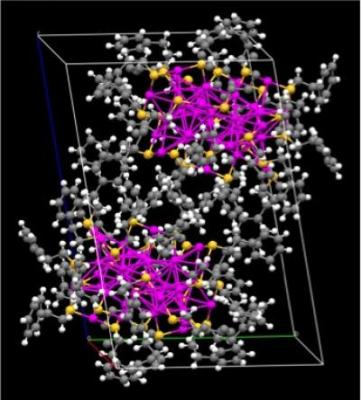Researchers at Carnegie Mellon University, Rongchao Jin and Roberto R. Gil have used nuclear magnetic resonance (NMR) spectroscopy to study the structure of gold nanoparticles, paving the way to improve the synthesis and application of the materials in drug development.
 Pictured is the crystal structure of a pair of gold nanoparticles that exist in a right-handed (bottom) and left-handed (top) configuration. These nanoparticles hold great promise as a chiral catalyst -- a tool highly sought-after by the pharmaceutical industry. (Credit: Carnegie Mellon University)
Pictured is the crystal structure of a pair of gold nanoparticles that exist in a right-handed (bottom) and left-handed (top) configuration. These nanoparticles hold great promise as a chiral catalyst -- a tool highly sought-after by the pharmaceutical industry. (Credit: Carnegie Mellon University)
The application of NMR spectroscopy allows the researchers to study the existence of chirality, a phenomenon representing the presence of left-handed and right-handed configuration, in gold nanoparticles. A nanoparticle with a chirality phenomenon can be used as a chiral catalyst, a highly demanded material in the pharmaceutical industry. A drug containing both configurations is inferior in efficiency, as one of the configurations or isomers may cause damage. Hence, drug manufacturers are seeking methods to synthesize materials that comprise only either of these isomers.
The gold nanoparticles synthesized by the university researchers are capable of catalyzing chemical reactions that will create only the right- or left-handed isomer. The nanoparticle having a diameter of 1.4 nm comprises exactly 38 gold atoms. Huifeng Qian, one of the researchers, had spent almost a year for the development of superior quality crystals from the nanoparticles in order to analyze their structure utilizing X-ray crystallography.
The X-ray crystallography study confirmed that Jin’s gold nanoparticle has a chiral structure. Researchers normally use circular dichoism spectroscopy to study gold nanoparticles’ chiral structure. However, this technique is not suitable for Jin’s gold nanoparticles, as they are a mix comprising equal amounts of each isomer called racemates. Hence, the university researchers used the NMR spectroscopy method.
The chiral core of Jin's gold nanoparticle that comprises numerous chemical substances, includes freely revolving methylene groups that stimulate two hydrogen atoms of these methylene groups to release various frequencies, an effect termed as the diastereotopicity phenomenon. During the comparison study of NMR signals released from the hydrogen atoms of chiral gold nanoparticle with that of non-chiral gold nanoparticle, the NMR spectrum of the chiral nanoparticle released two various hydrogen signals, while that of non-chiral nanoparticle did not show any variations. Based on the differences, the researchers were able to identify a chiral particle even for racemates.
According to Jin, NMR spectroscopy is also capable of detecting the purity of a nanoparticle mix. At present, Jin and Qian are trying to convert their 50/50 mix of left- and right-handed isomers into a pure solution comprising only either of the isomers.
Source: http://www.cmu.edu